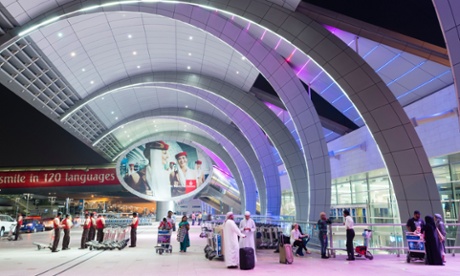
Kamila Shamsie, The Guardian, March 30, 2015
I have never had a fear of flying, but for many years I had a dread of airports. During the 90s, while a university student in America, I would fly back and forth between Karachi and the east coast twice a year, on an American Airlines/Gulf Air combo. The travel time was nearly 36 hours and included five airports – JFK, Heathrow, Bahrain, Doha/Muscat, Karachi. There was rarely a trip without some near calamity brought on by a range of factors: blizzards, missed connections, repairs, officials who didn’t much like the look of my Pakistani passport, or the stamps of a suspicious country (Jordan) in it.
But over and above all this, there was the boredom, or the various shades of boredom, the worst of which is the one that arises 30 hours in, when your brain has no capacity for anything but the thought: get me out of this terminal. This thought recurred with particular frequency during the four-hour layovers in Bahrain, where the pianist who was the airport’s sole form of entertainment insisted on playing The Wind Beneath My Wings. It might have been the closest thing to an aeronautical song he knew. Boarding always felt like release; airports themselves were like cages.
That was then. Today, I regard transit time with a jauntiness that borders on enthusiasm. When did it all change? Not when, so much as where: Dubai airport. If the 90s were the decade of Gulf Air, the noughties belonged to Emirates. By this time, my travel to and from Karachi originated in London – and by this time, too, most of the world’s airlines had stopped flying to Karachi. Emirates, with its frequent daily flights, was almost the default choice.
In the early days, still scarred from those years of multiple transit lounges, I asked nothing of a terminal except that I should be allowed to leave it at the time printed on my ticket. And so it was with Dubai, which I would pace the length of over and over while ignoring the brightly lit duty free lower ground floor, bypassing the crowded cafes and fast food joints.
This might have gone on for years (and, indeed, sometimes it did feel as though it went on for years) if a friend hadn’t mentioned a bar called Wings near the business centre, two levels above the duty free, where hardly anyone thought to venture. Here, I discovered, it was possible to sit on a comfortable chair, with a view of Dubai’s ever growing skyline, nursing a glass of Perrier for several hours.
Near me are a bunch of plasticky trees. I don’t know if they are plastic or if it’s just the atmosphere of this place
At Wings, I realised how much I appreciate an airport that allows me to look out rather than at other people. You’d think a writer might regard an airport as a place of possibilities – so many destinations and points of departure, so many stories. And yet I always ensure I’m carrying a book, not as reading matter but as a shield to ward off anyone who might think I’m a target for conversation. There is an odd blankness to my brain, whether I’ve been travelling three or 30 hours, as though I am taking too literally this concept of being in transit: I’m unable to read, unwilling to speak, paused.
Then, in 2007, I discovered free Wi-Fi, and everything changed. For some reason, still only dimly apprehended, there is nowhere else I am so efficient about answering all those emails that have been sitting in my inbox for so long they’re ready to claim squatters’ rights. Now, when my unanswered emails rise in number, I sometimes find myself thinking: when will I next be at an airport? Airport limbo is no longer a state of boredom, a pause between departure and arrival; it is that rare space in which all the world’s demands and questions are answered, and a weightlessness takes their place. “She had answered all her emails, and was ready to board the flight”: start a novel with this line and the tone is one of triumph and possibility (shortlived, but meaningful).

Dubai International airport’s Terminal 3. Photograph: Alamy
Wings, the bar, is history now, at least for anyone who travels Emirates. In 2008, a new terminal opened, and in January the following year I emailed friends from it to say: “Am in a newly completed terminal, which is the most shiny structure in which I’ve ever found myself. Near me are a bunch of plasticky trees. I don’t know if they really are plastic or if it’s just the atmosphere of this place.” I didn’t know it then, but my relationship with Dubai International was near an end; soon I would switch my frequent flyer allegiances and Doha would become my primary place of transit between Heathrow and Karachi.
In my decade of passing through Dubai, I never once exited its airport, a fact I wore as a badge of honour. And why would I, given all that I held against the state – its labour practices, its hypercapitalism, its sheer megalomania?
But it is only now that I have to face the truth: for all my attempted disdain, Dubai airport is the place where I learned to stop worrying and love a transit lounge.
• Kamila Shamsie is the author of six novels, most recently A God In Every Stone.
This article originally appeared on guardian.co.uk
This article was written by Kamila Shamsie from The Guardian and was legally licensed through the NewsCred publisher network.
![]() https://images4.newscred.com/cD1jMDY5MGZkNDEwNjM3N2E4YTlmZGUxZDNjODcxZGVhMSZnPWI5YmY3NjEyM2NjZWY5OGY3YWFlNGE3Y2U4ZDBkZjNm
https://images4.newscred.com/cD1jMDY5MGZkNDEwNjM3N2E4YTlmZGUxZDNjODcxZGVhMSZnPWI5YmY3NjEyM2NjZWY5OGY3YWFlNGE3Y2U4ZDBkZjNm